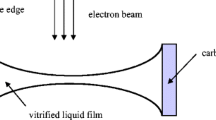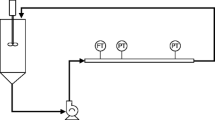Abstract
The effect of the counterion salt sodium salicylate (Nasal) on the transient rheological properties of a drag-reducing surfactant system tris (2-hydroxyethyl) tallowalkyl ammonium acetate (TTAA) has been studied with both rheometric and rheo-optical methods. Three types of transient behavior for N1 and viscosity were identified in 5 mM TTAA solutions depending on the counterion concentration: induction and growth (below equimolar concentration); overshoot and growth (above equimolar concentration); and overshoot then plateau (at high concentrations of Nasal). The transient flow birefringence and orientation angle show trends similar to those of the viscosity and N1. The second type of transient behavior suggests a two-stage alignment and shear thickening process. The SIS buildup time from the quiescent state, the rebuilding time after a strong preshear, and the relaxation time were also obtained from N1 measurements, and show a maximum around equimolar conditions. The initial N1 and viscosity immediately after the flow startup, on the other hand, show a maximum around a ratio of 2.5 to 3 Nasal/TTAA. For solutions with a Nasal concentration in the ratio 1.5 to 3, the steady state values of N1 and viscosity do not show much variation with Nasal concentration over the shear rate range covered, however. The effect of an addition of sodium chloride (NaCI) to an equimolar Nasal/TTAA solution on the characteristic times and steady state values was also quantified. These rheological results provide us with tools to determine the optimal concentration ratio for practical drag reduction applications.
Similar content being viewed by others
References
Bewersdorff HW, Frings B, Linder P, Oberthür RC (1986) The conformation of drag reducing micelles from small-angle neutron scattering experiments. Rheol Acta 25:642–646
Bewersdorff HW, Dohmann J, Langowski J, Linder P, Maack A, Oberthür RC, Thiel H (1989) SANS and LS studies on drag reducing surfactant solutions. Physica B 156–157:508–511
Bruinsma R, Gelbart WM, Ben-Shaul A (1992) Flow induced gelation of living (micellar) polymers. J Chem Phys 96(10):7710–7727
Butler PD, Magid LJ, Hamilton WA, Hayter JB, Hammouda B, Kreke PJ (1996) Kinetics of alignment and decay in a highly entangled transient threadlike micellar network studied by smallangle neutron scattering. J Phys Chem 100:442–445
Cates ME (1990) Nonlinear viscoelasticity of wormlike micelles (and other reversibly breakable polymers). J Phys Chem 94:371–375
Chou L, Zakin J (1991) Use of mixed cations and mixed counterions to extend the effective temperature range for drag-reducing surfactant additives. Proc Intl Symp on Fluids for district heating, Copenhagen
Chou L, Christensen RN, Zakin JL (1989a) The influence of chemical composition of quaternary ammonium salt cationic surfactants on their drag-reducing effectiveness. In: Sellin, Moses (eds) Drag reduction in fluid flows, pp 141–148. Ellis Horwood, Chichester
Chou L, Christensen RN, Zakin JL (1989b) Drag-reducing additives for cooling systems. Proc IDHCA Conf, Virginia Beach, pp 352–367, IDHCA Pub
Gasljevic K, Matthys EF (1993) On saving pumping power in hydronic thermal distribution systems through the use of drag-reducing additives. Energy and Buildings, 20, pp 45–56
Gasljevic K, Matthys EF (1994) Hydrodynamic and thermal field development in the pipe entry region for turbulent flow of drag-reducing surfactant solutions. In: Developments in Non-Newtonian Flows II, FED Vol 206/AMD Vol 191, 51–61. ASME Pub, New York
Hoffmann H, Hofmann S, Rauscher A, Kalus J (1991) Shear-induced transitions in micellar solutions. Progr Colloid Polymer Sci 84:24–35
Hofmann S, Rauscher A, Hoffmann H (1991) Shear-induced micellar structures. Ber Bunsenges Phys Chem 95: 153–164
Hofmann S, Stern P, Myska J (1994) Rheological behavior and birefringence investigations on drag-reducing surfactant solutions of tallow-(tris-hydroxyethyl)ammonium acetate/sodiumsalicylate mixtures. Rheol Acta 33:419–430
Hu Y, Wang SQ, Jamieson AM (1993) Rheological and flow birefringence studies of a shear-thickening complex fluid-a surfactant model system. J Rheol 37:531
Hu Y, Rajaram CV, Wang SQ, Jamieson AM (1994) Shear thickening behavior of a rheopectic micellar solution: salt effects. Langmuir 10:80–85
Hu Y, Wang SQ, Jamieson AM (1995) Rheological and rheo-optical studies of shear-thickening polyacrylamide solutions. Macromolecules 28:1847–1853
Hu Y, Matthys EF (1995) Micellar structure characteristic times under shear flow for a drag-reducing surfactant solution: Normal stress studies and flow geometry effects. Rheol Acta 34:450–460
Jindal VK, Kalus J, Pilsl H, Hoffmann H, Lindner P (1990) Dynamic small-angle neutron scattering study of rodlike micelles in a surfactant solution. J Phys Chem 94:3129–3138
Kalus J, Hoffmann H, Chen SH, Lindner P (1989) Correlations in micellar solutions under shear: A small-angle neutron scattering study of the chain surfactant Nhexadecyloctyldimethylammonium bromide. J Phys Chem 93:4267–4276
Macosko CW (1994) Rheology principles, measurements and applications. VCH, New York
Myska J, Stern P (1994) Properties of a drag reducing micelle system. Colloid Polym Sci 272:542
Ohlendorf D, Interthal W Hoffmann H (1986) Surfactant systems for drag reduction: Physicochemical properties and rheological behavior. Rheol Acta 25:468–486
Pearson DS, Kiss AD, Lewis JF (1989) Flow-induced birefringence of concentrated polyisoprene solutions. J Rheol 33:517–535
Rehage H, Hoffmann H (1988) Rheological properties of viscoelastic surfactant systems. J Phys Chem 92:4712–4719
Rose GD, Foster KL (1989) Drag reduction and theological properties of cationic viscoelastic surfactant solutions. J Non-Newtonian Fluid Mechanics (31), pp 59–85
Shikata T, Hirata H, Kotaka T (1987) Micelle formation of detergent molecules in aqueous media: Viscoelastic properties of aqueous cetyltrimethylammonium bromide solutions. Langmuir 3:1081–1086
Shikata T, Hirata H, Kotaka T (1988) Micelle formation of detergent molecules in aqueous media: 2. Role of free salicylate ions on viscoelastic properties of aqueous cetyltrimethylammonium bromide-sodium salicylate solutions. Langmuir 3:354–359
Shikata T, Hirata H, Kotaka T (1989) Micelle formation of detergent molecules in aqueous media. 3. Viscoelastic properties of aqueous cetyltrimethylammonium bromide-salicylic acid solutions. Langmuir (5), pp 398–405
Smith BC, Chou LC, Zakin JL (1994) Effect of counterion structure on flow birefringence and drag reduction behavior of quaternary ammonium salt cationic surfactants. ACS Symp Series 576, pp 370–379
Wang SO (1991) Growth of dynamic polymers (micelles) in shear flow. Macromolecules 24:3004–3009
Zakin J, Porch M, Brosh A, Warshavsky M (1971) Exploratory study of friction reduction in slurry flows. AIChE Symp Series, Vol 67, pp 85–89
Author information
Authors and Affiliations
Rights and permissions
About this article
Cite this article
Hu, Y., Matthys, E.F. The effects of salts on the rheological characteristics of a drag-reducing cationic surfactant solution with shear-induced micellar structures. Rheola Acta 35, 470–480 (1996). https://doi.org/10.1007/BF00368997
Received:
Accepted:
Issue Date:
DOI: https://doi.org/10.1007/BF00368997




